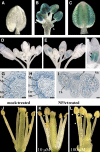Auxin regulates Arabidopsis anther dehiscence, pollen maturation, and filament elongation
- PMID: 18628351
- PMCID: PMC2518247
- DOI: 10.1105/tpc.107.057570
Auxin regulates Arabidopsis anther dehiscence, pollen maturation, and filament elongation
Abstract
We provide evidence on the localization, synthesis, transport, and effects of auxin on the processes occurring late in Arabidopsis thaliana stamen development: anther dehiscence, pollen maturation, and preanthesis filament elongation. Expression of auxin-sensitive reporter constructs suggests that auxin effects begin in anthers between the end of meiosis and the bilocular stage in the somatic tissues involved in the first step of dehiscence as well as in the microspores and in the junction region between anther and filament. In situ hybridizations of the auxin biosynthetic genes YUC2 and YUC6 suggest that auxin is synthesized in anthers. In agreement with the timing of auxin effects, the TIR1, AFB1, AFB2, and AFB3 auxin receptor-encoding genes are transcribed in anthers only during late stages of development starting at the end of meiosis. We found that in tir1 afb triple and quadruple mutants, anther dehiscence and pollen maturation occur earlier than in the wild type, causing the release of mature pollen grains before the completion of filament elongation. We also assessed the contribution of auxin transport to late stamen developmental processes. Our results suggest that auxin synthesized in anthers plays a major role in coordinating anther dehiscence and pollen maturation, while auxin transport contributes to the independent regulation of preanthesis filament elongation.
Figures









Comment in
-
Auxin regulation of late stamen development.Plant Cell. 2008 Jul;20(7):1733. doi: 10.1105/tpc.108.200712. Epub 2008 Jul 22. Plant Cell. 2008. PMID: 18647823 Free PMC article. No abstract available.
References
-
- Aloni, R., Langhans, M., Aloni, E., and Ullrich, C.I. (2006). Role of auxin in regulating Arabidopsis flower development. Planta 223 315–328. - PubMed
-
- Blilou, I., Xu, J., Wildwater, M., Willemsen, V., Paponov, I., Friml, J., Heidstra, R., Aida, M., Palme, K., and Scheres, B. (2005). The PIN auxin efflux facilitator network controls growth and patterning in Arabidopsis roots. Nature 433 39–44. - PubMed
-
- Bonner, L.J., and Dickinson, H.G. (1989). Anther dehiscence in Lycopersicon esculentum Mill. I. Structural aspects. New Phytol. 113 97–115. - PubMed
-
- Bowman, J. (1994). Arabidopsis: An Atlas of Morphology and Development. (New York: Springer-Verlag).
-
- Cecchetti, V., Altamura, M.M., Serino, G., Falasca, G., Costantino, P., and Cardarelli, M. (2007). ROX1, a gene induced by rolB, is involved in procambial cell proliferation and xylem differentiation in tobacco stamen. Plant J. 49 27–37. - PubMed
Publication types
MeSH terms
Substances
LinkOut - more resources
Full Text Sources
Molecular Biology Databases

